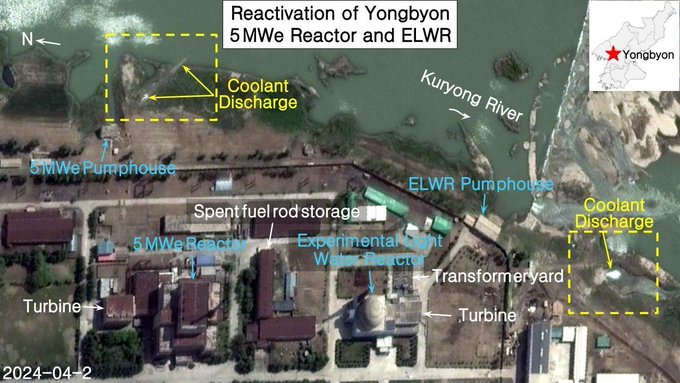New satellite images indicate that North Korea is working to increase its production of plutonium and uranium, according to a recent report, raising fears that the country is developing nuclear weapons. The photos, taken by commercial photography company Maxar and published by Daily NK, show heavy activity at the Yongbyon Nuclear Complex, a uranium enrichment plant in North Pyongan Province, which the United States is trying to shut down through economic sanctions.
High-resolution thermal infrared images taken on May 14 indicate that coolant, which is circulated through a nuclear reactor to remove or transfer heat, is being discharged into the Koryong River, which surrounds the facility, Daily NK reported. This is the 11th episode of coolant discharge discovered this year, according to the same media outlet.
Recent satellite images indicate that North Korea is resuming testing operations for its experimental light water reactor at Yongbyon. https://t.co/1u4UiwyJO2 pic.twitter.com/q1okeY93xb
– Daily NK (@The_Daily_NK) May 22, 2024
Thermal images also show significant energy releases from the radiochemistry laboratory and uranium enrichment facility, indicating that these sites are operational. Infrared thermal images from NASA’s Landsat 8 satellite confirm these findings, showing temperature distributions in Yongbyon ranging from 13 to 28 degrees Celsius. High temperatures at the radiochemistry laboratory and uranium enrichment facility indicate that these sites process spent fuel rods into plutonium and produce highly enriched uranium.
High-resolution satellite images and infrared thermal satellite images indicate this #north korea Fissile material could be produced at the Yongbyon nuclear complex in North Pyongan Province. https://t.co/DrSLzbchM7 pic.twitter.com/mAo1H5g5xt
– Daily NK (@The_Daily_NK) May 23, 2024
In September 2021, satellite images taken by Maxar also showed that North Korea was expanding the Yongbyon nuclear complex. The expansion could allow North Korea to increase production of military nuclear materials by up to 25%, Jeffrey Lewis, a weapons expert and professor at the Middlebury Institute of International Studies, told CNN at the time.
“The recent expansion at Yongbyon likely reflects plans to increase the production of nuclear material for weapons production,” Lewis said, adding that construction was consistent with previous efforts to increase available space at the facility, allowing it to house more centrifuges and thus enrich more uranium. annually.
A month before Lewis’s comments, the International Atomic Energy Agency, the UN watchdog, issued a report that cited “deeply worrying” signs that North Korea had resumed operation of a nuclear reactor that was previously believed to have been destroyed and had been used to produce plutonium for weapons. Nuclear.
The agency said, “The continuation of the DPRK’s nuclear program is a clear violation of the relevant UN Security Council resolutions, which is extremely regrettable.”
In 2019, North Korea proposed closing part of its Yongbyon nuclear complex in exchange for the lifting of all UN sanctions except those directly targeting its weapons of mass destruction programs. However, no agreement was reached.
The latest activities at the complex coincide with North Korea’s ongoing missile tests and vertical engine tests at the Sohae satellite launch station. North Korean leader Kim Jong Un stressed the need to increase nuclear production to strengthen the country’s arsenal.

“Hardcore alcohol maven. Hipster-friendly analyst. Introvert. Devoted social media advocate.”

